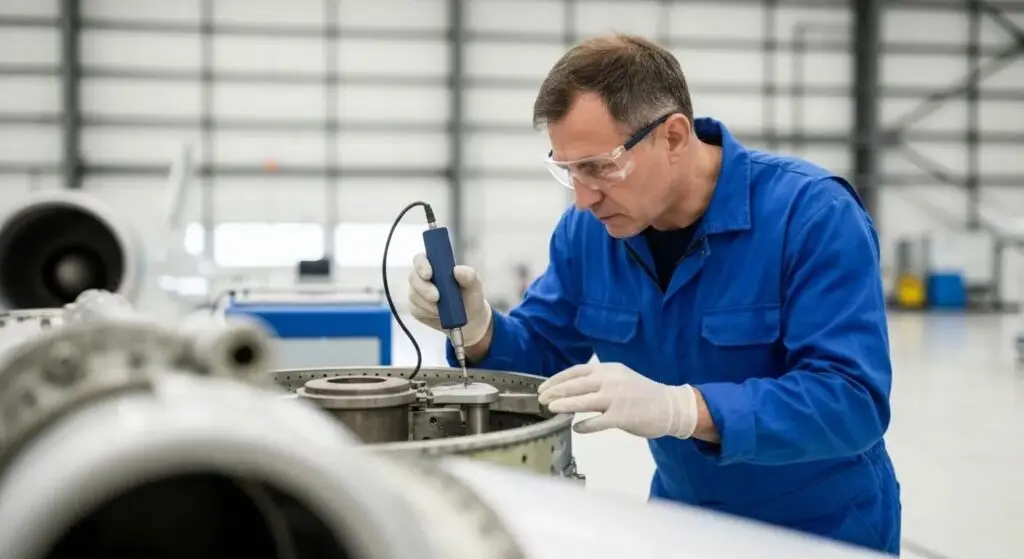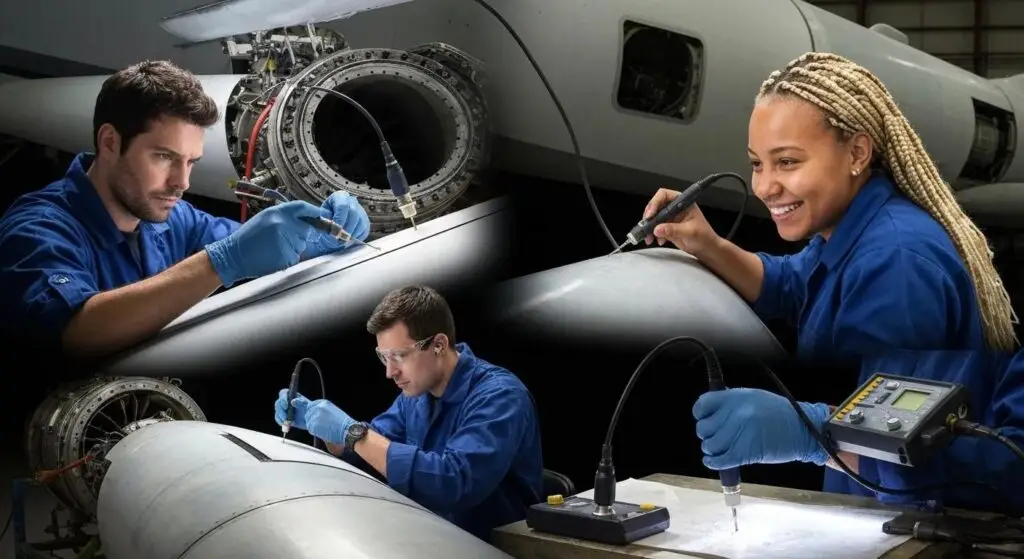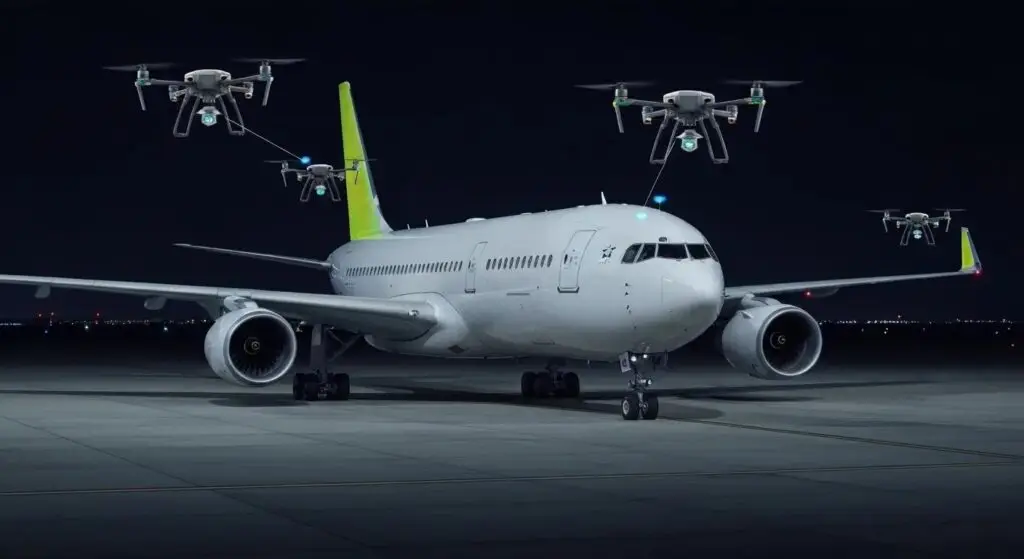
Every year, non-destructive testing in aviation uncovers hidden defects that could lead to catastrophic failures, safeguarding passenger lives and operational continuity. This article explains what aviation NDT services entail, explores core inspection methods, outlines compliance with industry standards, highlights Baron NDT’s unique advantages, examines component-specific applications, surveys emerging technologies, and shows how maintenance facilities benefit from partnering with Baron NDT.
Aviation NDT services evaluate aircraft structures and components without causing damage, using methods such as ultrasonic waves, electromagnetic fields, and infrared imaging to reveal cracks, corrosion, and bonding issues. By detecting flaws early, these inspections prevent in-flight failures, extend component life, and ensure airworthiness across maintenance cycles.
Non-destructive testing in aviation refers to a suite of inspection techniques that reveal internal or surface flaws without impairing the part under test. It uses energy forms—acoustic, magnetic, radiographic, or thermal—to interrogate materials, producing diagnostic data that confirms structural integrity and informs maintenance decisions. This method preserves components while ensuring they meet rigorous safety requirements.
NDT services enhance safety and reliability by uncovering hidden defects before they propagate into critical failures.
These benefits directly support regulatory compliance and operational efficiency, preparing aircraft for safe return to service.
Maintenance programs target high-stress or safety-critical parts for NDT inspections, including:
Regular inspection of these elements prevents in-service failures and underpins reliable aircraft operation.

Aircraft NDT methods span a range of technologies to detect both surface and internal flaws, each offering distinct advantages in sensitivity and application.
| Method | Application Area | Detection Capability |
|---|---|---|
| Ultrasonic Testing (UT) | Thick metal structures | Internal cracks and corrosion |
| Phased Array Ultrasonics (PAUT) | Complex geometries | Detailed imaging and flaw sizing |
| Magnetic Particle Inspection | Ferromagnetic parts | Surface and near-surface discontinuities |
| Eddy Current Testing (ET) | Conductive materials | Surface and subsurface cracks |
| Liquid Penetrant Testing (LPT) | Non-porous exterior surfaces | Fine surface-breaking flaws |
| Radiographic Testing (RT) | Critical load-bearing parts | Internal voids, porosity, and inclusions |
| Thermography | Composite and bonded structures | Thermal anomalies indicating defects |
This article provides a comprehensive overview of non-destructive testing (NDT) techniques employed in the aviation industry. It highlights their significance in assessing structural integrity, reducing maintenance costs, and enhancing operational safety, detailing various NDT methods such as ultrasonic, eddy current, radiographic, magnetic particle, and dye penetrant testing, along with their principles and applications.
This research directly supports the article’s explanation of what aviation NDT services entail, the essential nature of NDT, and the various methods used in aircraft non-destructive testing.
Ultrasonic testing uses high-frequency sound waves transmitted into a component; reflections from internal discontinuities indicate crack or corrosion locations. By measuring echo time and amplitude, inspectors map defect size and position, ensuring precise detection in thick metal parts. This method enhances structural safety by revealing otherwise invisible flaws.
Phased array ultrasonics steers multiple sound beams electronically to scan complex geometries in a single pass. It produces cross-sectional images of materials, enabling accurate flaw characterization and sizing. This advanced UT technique reduces inspection time, improves repeatability, and supports real-time analysis for critical aerospace components.
Magnetic particle inspection magnetizes a ferromagnetic part, then applies fine magnetic particles that concentrate at surface or near-surface discontinuities. Under ultraviolet or visible light, these particle indications reveal cracks or laps. MPI offers rapid detection on landing gear, shafts, and fasteners, delivering clear visual proof of surface defects.
Eddy current testing induces alternating currents in conductive materials to detect variations in electrical impedance caused by cracks or corrosion. Portable probes scan aircraft skins, fastener holes, and rotor discs, delivering immediate flaw feedback. ECT minimizes disassembly and provides high-resolution detection of near-surface defects.
Liquid penetrant testing applies a visible or fluorescent dye to cleaned surfaces, allowing capillary action to draw penetrant into fine cracks. After wiping and developer application, surface-breaking flaws become visible under white or ultraviolet light. LPT excels at detecting tight surface defects in non-porous components such as composite panels.
Radiographic testing employs X-rays or gamma rays passed through a component onto a detector; areas of reduced density appear darker, revealing internal voids, porosity, or inclusions. RT provides a permanent image record and is especially useful for thick or complex parts where ultrasonic access is limited.
Thermography uses infrared cameras to monitor temperature differences on a part’s surface. Subsurface defects alter heat flow, creating thermal anomalies that highlight delamination, bonding failures, or voids. This non-contact method speeds up composite inspections and captures large areas without physical coupling.
Aviation NDT providers must adhere to stringent regulations and certification frameworks to ensure inspection validity, technician competence, and traceable reporting.
FAA and EASA require NDT technicians to hold Level I, II, or III certifications under NAS 410 and EN 4179 standards. Repair stations must maintain FAA Repair Station Certification (Parts 145) or EASA Part-145 approvals, demonstrating audited quality systems and trained personnel.
Baron NDT employs ASNT SNT-TC-1A compliant procedures and ensures all technicians attain NAS 410 Level II or III qualifications through accredited training and practical examinations. Robust internal audits, documented calibration, and strict quality controls affirm adherence to recognized aerospace standards.
Regulatory compliance assures that inspections are performed by qualified personnel using calibrated equipment and validated procedures. This oversight guarantees consistent safety levels, facilitates regulatory audits, and supports insurance and liability requirements for maintenance operators.
Partnering with Baron NDT delivers measurable advantages that enhance safety, reduce costs, and streamline maintenance.
Baron NDT’s investment in phased array ultrasonics, digital radiography, and automated eddy current scanning accelerates inspection cycles and improves defect resolution. Faster turnarounds lower labor expenses and curtail ground time, maximizing fleet availability for maintenance facilities.
By combining rigorous qualification programs, calibrated instrumentation, and documented traceability, Baron NDT consistently uncovers critical flaws before they compromise structural integrity. This proactive approach safeguards passengers, supports regulatory audits, and reinforces confidence in airworthiness.
Baron NDT collaborates closely with maintenance teams to customize inspection plans, schedule on-site services in Beaumont and Jacksonville, and deliver clear, actionable reports. This tailored support fosters trust, ensures seamless integration, and aligns inspections with each facility’s operational needs.
Component-focused inspection strategies marry the most effective NDT techniques to each structure’s material and design.
| Component | Preferred NDT Method | Key Advantage |
|---|---|---|
| Fuselage skin and frames | Ultrasonic Testing | Detects internal corrosion and fatigue |
| Wing spars and ribs | Phased Array Ultrasonics | Captures complex geometries in one scan |
| Landing gear assemblies | Magnetic Particle & Eddy Current | Reveals surface cracks with minimal prep |
| Engine turbine blades | Radiographic Testing | Visualizes subsurface porosity |
| Composite panels | Thermography | Rapidly maps delamination and voids |
Ultrasonic testing evaluates fuselage skins and wing spars by transmitting longitudinal or shear waves through the material. Echo patterns identify crack depth, corrosion pockets, and bonding issues. This method supports preventive maintenance by pinpointing flaw volume and propagation trends.
Landing gear and engine parts benefit from magnetic particle inspection for surface crack detection and eddy current testing for subsurface flaw mapping. Radiographic testing complements these methods for thick castings and welds, providing a complete defect profile in critical load-bearing assemblies.
Thermography maps heat flow across composite surfaces; regions with disbond or delamination exhibit thermal contrasts under pulsed or lock-in excitation. This non-contact approach scans large areas quickly, revealing bonding defects that compromise structural integrity in composite control surfaces.

Innovations in data analysis, automation, and imaging are redefining inspection speed, accuracy, and safety.
Machine learning algorithms process large datasets from ultrasonic, eddy current, and radiographic scans to recognize subtle defect signatures and reduce operator variability. AI-driven analysis improves consistency and accelerates inspection throughput by flagging anomalies in real time.
Robotic crawlers and unmanned aerial systems carry NDT sensors into hard-to-reach areas such as high wing surfaces and vertical tails. Automation enhances safety by reducing technician exposure, while drones equipped with thermographic or ultrasound payloads collect data from elevated structures without scaffolding.
Digital radiography replaces film with advanced flat-panel detectors and computed tomography techniques to generate high-resolution, 3D defect reconstructions. This leap in imaging clarity supports precise volumetric analysis, reduces retakes, and streamlines reporting for critical aerospace parts.
This article explores the evolving landscape of non-destructive testing in aerospace, highlighting key innovations for 2025. It discusses advancements such as AI signal analysis for improved defect detection and automated thermographic drones for enhanced inspection efficiency, addressing the industry’s shift towards lighter materials and net-zero operations.
This source directly supports the article’s section on emerging technologies, specifically the roles of AI, machine learning, robotics, and digital radiography in enhancing defect detection and inspection precision.
Engaging Baron NDT delivers proven results, local support, and straightforward pathways to request services.
Baron NDT’s phased array inspection of Boeing 737 lap splice assemblies detected fatigue cracks below visual thresholds, preventing unscheduled groundings. Digital radiography on composite business jet wings uncovered hidden debonding, enabling cost-effective targeted repairs.
Baron NDT maintains regional teams equipped for on-site ultrasonic, eddy current, and thermographic inspections, backed by a mobile laboratory. Local certified technicians coordinate with facility planners to integrate inspections seamlessly into maintenance programs, maximizing uptime.
Maintenance managers can initiate a consultation by contacting Baron NDT’s regional offices to discuss scope, schedule, and technical requirements. A tailored proposal outlines inspection methods, delivery timelines, and transparent pricing to meet each facility’s operational priorities.
Baron NDT’s comprehensive aviation NDT offerings help maintenance facilities achieve the highest safety standards, reduce maintenance costs, and embrace emerging inspection technologies for future-proof fleet readiness. By combining certified expertise, advanced methods, and customer-focused service, Baron NDT stands ready to support aviation operations from initial consultation through detailed reporting.
aviation ndt, baron ndt, aircraft ndt inspection, aircraft structural ndt inspections, lycoming engine ndt services, nondestructive testing services acoustic thermal inspection, aerospace ndt inspection services, aviation ndi services, ndt aircraft, the importance of ndt application in commercial aircraft maintenance industry
aviation ndt, baron ndt, aircraft ndt inspection, aircraft structural ndt inspections, lycoming engine ndt services, nondestructive testing services acoustic thermal inspection, aerospace ndt inspection services, aviation ndi services, ndt aircraft, the importance of ndt application in commercial aircraft maintenance industry